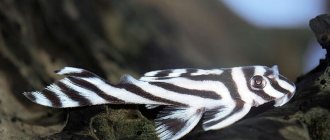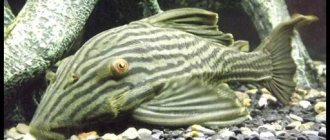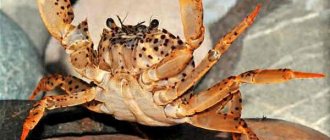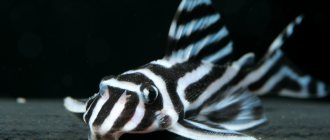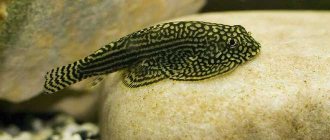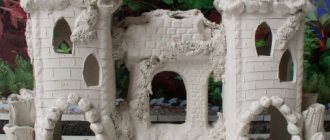Where to buy l catfish?
Our nursery features over 50 aquariums with many popular aquarium fish and rare species. Employees treat the process of keeping and breeding fish with great care and understanding. Therefore, all catfish are top quality fish with good health, bright colors, as you can see in the photos on this site.
We are always happy to provide the necessary information about the maintenance, nutrition, and breeding of catfish. To buy the type you like, just select from the photo and call. We send orders throughout Moscow and throughout Russia, providing transport guarantees.
Hypancistrus sp. "L066"
Name: Hypancistrus sp. “L066” Synonyms: King Tiger Pleco Habitat: Rio Xingu, nahe Belo Monte, Para, Brazil First description: Datz 9/1990 Size: 15-18 cm Water parameters: t: 26-30 °C pH: 5–7dh
Sexual differences: Females, like males, have odontodes behind the gill covers, so it would not be correct to distinguish only on this basis. Only individuals of the same age and size can be sufficiently accurately determined by sex when compared simultaneously.
Male Hypancistrus sp.”L066″
Adult representatives of this species of Chain catfish can already be identified by body shape and head size. Sexually mature males of Hypancistrus sp. “L066” have well-defined odontodes on the first rays of the pectoral fins, and “shaggy” appearance appears on the caudal peduncle. Experienced aquarists are able to distinguish the sex of a catfish by its genital organs, but this is not possible for all aquarists and is possible only after the individual has reached sexual maturity. Females that have collected eggs have a more voluminous body.
Male Hypancistrus sp.”L066″
Socialization: Hypancistrus sp. “L066” rather belongs to the calm, peace-loving species of Loricariid catfish and does not show aggression towards its neighbors in the aquarium.
Contents: When keeping a group of these catfish, it is necessary to visually divide the territory into certain areas, which will promote comfortable living together and reduce aggression between relatives.
For a small group of 4-5 catfish, an aquarium with a length of about 100 cm is suitable; when keeping a larger group, the volume and size should be increased in proportion to the population density. It is advisable to decorate the aquarium with stones, driftwood and tree roots several levels up to the surface and provide a sufficient number of shelters and tubes. This is a very good solution if you are limited by the size of the aquarium. The lighting in the aquarium should not be bright - catfish of this species are nocturnal and try to retreat to their burrows in bright light. The number of tubes and other hiding places should outnumber the number of catfish in the aquarium. This gives the catfish a choice when selecting a shelter suitable for it in size and geographical location. Each individual is individual and has its own preferences both in terms of shelter location and nutrition. The ideal ratio would be 2 tubes per 1 catfish.
Hypancistrus sp.»L066″
These beautiful and fairly easy to keep catfish originate from the Xingu River in Brazil. The first location where these catfish were discovered was in the vicinity of the village of Belo Monte in the lower reaches of the Xingu River. They are also found much lower down the river. Other species of Loricariid catfish - such as: L333, L399, L400 . These catfish are similar to each other - this is precisely explained by the same halo of habitat. Temperature in the areas where Hypancistrus sp. was caught. "L066" ranges from 30 to 32°C, even reaching 35°C in some places. The water in these places is very well saturated with oxygen. The catch is carried out in rocky areas of rivers in cracks and depressions of rocky banks. These are the favorite habitats of these catfish.
Hypancistrus sp.”L066″
Recently, Hypancistrus sp. "L066" , like other species of Loricariids (L046) , is on the verge of extinction, due to the construction of a dam to generate electricity for the population of Brazil. Due to the damming of the river in some places, shallowing occurs in others, on the contrary - an increase in the water level. The speed of the river flow decreases, and therefore the oxygen saturation of the water decreases. No one can say how this will affect the population of these beautiful catfish in the future.
When kept in captivity,
Hypancistrus sp. "L066 " does not create any special difficulties. The acceptable keeping temperature is 28°C; soil and water parameters do not play a special role when kept in an aquarium. At lower temperatures, catfish growth becomes very slow. An increase in temperature entails a faster metabolic process and, as a result, growth accelerates, but at the same time the load on water increases. Regular mass water changes should be an integral factor in keeping this species of Chain Catfish . Aeration should also be stronger as the temperature rises. It is not recommended to keep Hypancistrus sp. together. “L066” with other Hypancistren , because there is a high risk of crossing and producing hybrids in the offspring. Catfish of other Loricariid can be kept together in the same aquarium. When kept together with large Cichlids, it is necessary to ensure that they do not bite the fins and tails of the catfish. When kept with peaceful fish species, such problems do not exist. If we talk about the lifespan of Hypancistrus sp. “L066” in captivity, then we can say for sure that the 13-14 year mark is not the limit. This conclusion is based on the testimony of people who kept this catfish in their aquariums for a long time. Feeding: During adolescence, Hypancistrus sp. “L066” is able to eat plant foods (potato slices, cucumber, lettuce), but as it grows, it gradually abandons such food and switches to more protein. Frozen food (bloodworm, karetra, cyclops, brine shrimp, etc.) will be eaten very well as a staple food and will promote growth. You can also offer fish fillets, shellfish and seafood as food. Dry food is also eaten with pleasure. In one word, we can call this species of chain catfish an omnivore.
Filtration: In an aquarium, in addition to a high-quality filtration system (biological, mechanical), it is advisable to install a flow pump for more intense mixing of the water and better saturation of the water with oxygen. You can add an air diffuser at the outlet of the pump - this will also be a good help to the basic aeration system. The dorsal fin of Hypancistrus sp. "L066" has 7 beams Soft. The adipose fin is not connected to the dorsal fin.
Hypancistrus sp.»L066″
Breeding: Since this species of Chain Catfish is prohibited from being caught and exported from Brazil (not included in the IBAMA “white list”), it is worth paying sufficient attention to breeding this beautiful catfish in captivity. You can hope for successful breeding with just a couple of Hypancistrus sp. "L066" , but the chances will increase if you have a group of manufacturers of 8-9 pieces. Stimulation of spawning will be a decrease in electrical conductivity and pH of water and mass replacements with a simultaneous decrease in temperature to 24-25°C. Spawning occurs, as with many Loricariid catfish, in tubes or grottoes. The size of the eggs often depends on the degree of maturation of the female and her size. The male cares for the eggs until the mature fry are released from the nest. It is better to rear young animals in separate containers with the same water parameters and enhanced aeration and filtration. This will promote more uniform growth of the fry and makes it easier to control water parameters. It is better if the nursery contains a sufficient number of small shelters for the fry - this will affect uniform growth, as well as its speed. At first, the fry prefers to eat more plant foods, but as it grows, it is necessary to offer it all types of food.
Similar catfish: Hypancistrus sp. “L260“ Hypancistrus sp. “L270“ Hypancistrus sp. “L316“,L 333 Hypancistrus sp. “L399” Hypancistrus sp. “L400” Hypancistrus sp. “L410” Hypancistrus sp.
"L411"
{jcomments on}
Hypancistrus L 333 Hypancistrus L 333
Hypancistrus L 333 belongs to the Loricariidae family and is one of the most popular fish species in this family. This fish species is often known as Ancistrus King Tiger. Naturally, Hypancistrus L333 looks similar to other representatives of loricariids, however, if you look closely, it becomes obvious that they have their own characteristics.
These fish originally come from Rio Xingu and to preserve this species, the catch and export of these fish is prohibited in Brazil. Therefore, many representatives of this species sold among aquarists are home bred.
In nature, hypancistrus L333 live in fast-flowing waters that are rich in oxygen and contain tannins, due to the abundance of wood in the water.
There are many color variations of these hypancistrus, so it is sometimes difficult to identify this species of fish, but the general color features are a yellow body color with dark brown irregular stripes. These fish will be a great addition to your aquarium. Adults can reach sizes of 10 to 15 cm and are very peaceful but can be territorial.
Hypancistrus L 333 is often confused with L 066, but taking a closer look at the colors of the fish it will immediately become clear that they are slightly different in color, since the stripes of L 333 are clearer and brighter.
Starting an aquarium.
When starting an aquarium for these hypancistrus, it is best to try to reproduce their natural habitat conditions. In this case, the fish will feel “at home”, and accordingly its color will become brighter and more beautiful. It is best to use sand or smooth gravel as a substrate, and there must be at least one driftwood and smooth stones in the aquarium to provide hiding places for the hypancistrus. Fish of this species do not like bright light, so floating plants should grow on the surface.
Hypancistrus L 333 prefer high quality water, which must have a flow, which can be achieved using a filter or pump. As mentioned above, the water must be rich in oxygen, and to maintain the water in good condition, regular changes are required. The water temperature in the aquarium should be approximately 25-31C, since these fish prefer warm water, and the pH level is around 6.0-7.0. Also, the water should be soft, as alkaline water will be harmful to the health of the fish.
In general, L 333 can be tolerant of other representatives of its species, but it will be better if there are only a few fish of this species in the aquarium (in addition, remember that fish do not grow small and an appropriate aquarium is needed to keep them). They can easily get along with other types of fish, but only if they are not bottom dwellers, but swim at their “level” in the water column. Almost all characinkas, peace-loving species of cichlids, tetras or rasboras are suitable for them as neighbors. Make sure you don't put them in the same tank as herbivorous fish species, as L333s are carnivores and mixing two different diets is not a good idea. If you plan to get your hypancistrus to spawn in the future, you will definitely need to add caves in the aquarium, for example from pots or pipes.
Feeding.
L333 aquarists have often had problems with it because they believe that these fish require the same diet as the omnivorous Loricariids. But hypancistrus definitely need a protein diet, and they can safely take plant foods only in their youth. As they grow older, their protein intake and requirements increase significantly. They need to be fed meat food, such as bloodworms, finely chopped mussels or shrimp. They will not eat algae, although they can eat dry food. They will completely ignore algae wafers thrown into the aquarium.
Dilution of L333.
While the fish are young, it is very difficult to distinguish a male from a female, but as they grow older, significant differences appear. In males, odontons develop on the pectoral fins and head. Females can also have them, but they are much smaller in size and not so noticeable. In addition, females have a more rounded body shape and are shorter in length. It takes almost two years for the fish to reach sexual maturity, so you should be patient and wait. It’s best to buy a small group to start with so that you eventually have at least one pair.
The easiest way to spawn hypancistrus is to transplant them from a common aquarium into their personal spawning tank, which should have several caves to choose from. The entrance to the caves should be quite a bit larger than the fish itself. if the entrance is too large, they will not pay any attention to this cave. Keep the oxygen level in the water high and make sure the pH level is no higher than 6.5.
In a general aquarium, the male chooses his favorite place for spawning, which he will selflessly defend, but in the spawning tank he will not need this due to the absence of other fish. The male will then try to lure the female to his chosen location, and once he succeeds, it may take several days before the eggs are laid and fertilized.
After this, the female no longer plays any role in nursing the offspring and the male often kicks her out of the nest. The male is responsible for caring for the eggs, so he spends all his free time protecting the future offspring and fanning them with his fins to create water circulation. After a few days, the eggs will hatch into fry, which will initially feed on their yolk sac. After the yolk sac disappears, they are able to eat regular food and believe me, they will be quite voracious. You can feed the fry with algae wafers, artemia nauplii, micro-worms and even crushed dry food in the form of flakes. Don't let them swim hungry, otherwise they will die. aqua-fish.net

